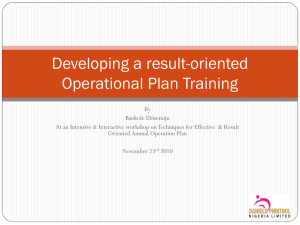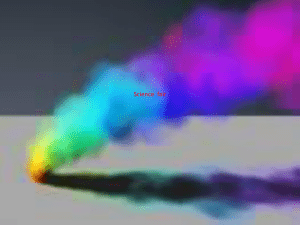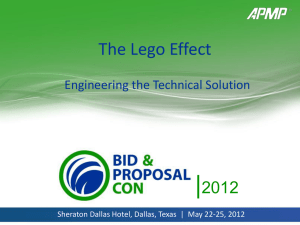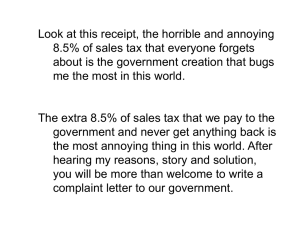Mitigating Transfer Station Safety and Health Risks During Planning
advertisement
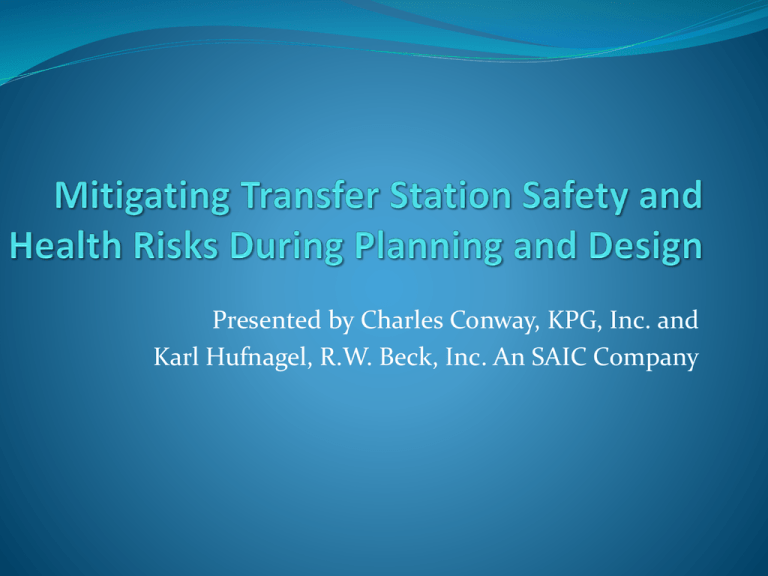
Presented by Charles Conway, KPG, Inc. and Karl Hufnagel, R.W. Beck, Inc. An SAIC Company What are the Health and Safety Hazards and Risks? Accidents/Injuries Falls, slips and trips Lacerations, punctures, cuts Flying objects and projectiles Collisions (vehicle-vehicle, vehicle-pedestrian, vehicle- building) Spill, splash and release of acids, caustics and toxics Material handling equipment moving parts Falling material Electrocution Heart attacks and other medical/health emergencies What are the Health and Safety Hazards and Risks? Fire Explosion Confined Space Hazards Environmental Exposure Dust Noise Toxic Fumes, Exhaust Gases and Smoke Infectious Agents Who are the Stakeholders? Stakeholders With Risk Exposure General Public (Customers) Commercial Haulers (Customers) Visitors – Tour Groups Operators Maintenance Staff Supervisory Staff Fire and Emergency Personnel Agency Oversight Staff These stakeholders represent a very broad spectrum of understanding and awareness of risks The risk exposure varies widely for these stakeholders Who are the Stakeholders? Stakeholders With Responsibilities Owner Operations Risk Management Engineering Health Department/District Department of Labor and Industries Code Officials Fire Officials Design Professionals Insurers Others? What are the Governing Codes and Regulations? International Building Code (IBC) International Fire Code (IFC) National Electrical Code (NEC) OSHA/WISHA Regulations National Fire Protection Association (NFPA) Standards Washington Administrative Code Public Health Ordinances Operating Permit(s) Owner’s Rules and Proceedures Other? Risks and Mitigation - General Fire and Smoke NFPA 13 fire sprinkler system Fire alarm Fire-rated wall/ceiling/roof assemblies Smoke control (smoke barriers, smoke venting) Egress (exits, exit corridors and pathways, areas of refuge, exit illumination and signage) Standby power generation General Health and Safety Risks First Aid Emergency showers and eyewashes EMT access (site access, access to machinery spaces, elevator cabs, training and drills) Risks and Mitigation - General Fire and Smoke NFPA 13 fire sprinkler system Fire alarm Fire-rated wall/ceiling/roof assemblies Smoke control (smoke barriers, smoke venting) Egress (exits, exit corridors and pathways, areas of refuge, exit illumination and signage) Standby power generation General Health and Safety Risks First Aid Emergency showers and eyewashes EMT access (site access, access to machinery spaces, elevator cabs, training and drills) Risks and Mitigation - General Fire and Smoke NFPA 13 fire sprinkler system Fire alarm Fire-rated wall/ceiling/roof assemblies Smoke control (smoke barriers, smoke venting) Egress (exits, exit corridors and pathways, areas of refuge, exit illumination and signage) Standby power generation General Health and Safety Risks First Aid Emergency showers and eyewashes EMT access (site access, access to machinery spaces, elevator cabs, training and drills) Risks and Mitigation - General Fire and Smoke NFPA 13 fire sprinkler system Fire alarm Fire-rated wall/ceiling/roof assemblies Smoke control (smoke barriers, smoke venting) Egress (exits, exit corridors and pathways, areas of refuge, exit illumination and signage) Standby power generation General Health and Safety Risks First Aid Emergency showers and eyewashes EMT access (site access, access to machinery spaces, elevator cabs, training and drills) Risks and Mitigation - General Fire and Smoke NFPA 13 fire sprinkler system Fire alarm Fire-rated wall/ceiling/roof assemblies Smoke control (smoke barriers, smoke venting) Egress (exits, exit corridors and pathways, areas of refuge, exit illumination and signage) Standby power generation General Health and Safety Risks First Aid Emergency showers and eyewashes EMT access (site access, access to machinery spaces, elevator cabs, training and drills) Risks and Mitigation - General Fire and Smoke NFPA 13 fire sprinkler system Fire alarm Fire-rated wall/ceiling/roof assemblies Smoke control (smoke barriers, smoke venting) Egress (exits, exit corridors and pathways, areas of refuge, exit illumination and signage) Standby power generation General Health and Safety Risks First Aid Emergency showers and eyewashes EMT access (site access, access to machinery spaces, elevator cabs, training and drills) Risks and Mitigation - General Fire and Smoke NFPA 13 fire sprinkler system Fire alarm Fire-rated wall/ceiling/roof assemblies Smoke control (smoke barriers, smoke venting) Egress (exits, exit corridors and pathways, areas of refuge, exit illumination and signage) Standby power generation General Health and Safety Risks First Aid Emergency showers and eyewashes EMT access (site access, access to machinery spaces, elevator cabs, training and drills) Risks and Mitigation - General Fire and Smoke NFPA 13 fire sprinkler system Fire alarm Fire-rated wall/ceiling/roof assemblies Smoke control (smoke barriers, smoke venting) Egress (exits, exit corridors and pathways, areas of refuge, exit illumination and signage) Standby power generation General Health and Safety Risks First Aid Emergency showers and eyewashes EMT access (site access, access to machinery spaces, elevator cabs, training and drills) Risks and Mitigation - General Fire and Smoke NFPA 13 fire sprinkler system Fire alarm Fire-rated wall/ceiling/roof assemblies Smoke control (smoke barriers, smoke venting) Egress (exits, exit corridors and pathways, areas of refuge, exit illumination and signage) Standby power generation General Health and Safety Risks First Aid Emergency showers and eyewashes EMT access (site access, access to machinery spaces, elevator cabs, training and drills) Risks and Mitigation – General Seismic Hazards Structural design Securing equipment and items posing hazard of falling material Standby power generation Risks and Mitigation – General Confined Spaces Ventilation Access control and signage Training Risks and Mitigation – Environmental Leachate Discharge Switchable sanitary/storm sewer collection system Tire wash equipment Risks and Mitigation – Environmental Dust and Odor Misting systems Dust control systems Risks and Mitigation – Environmental Dust and Odor Misting systems Dust control systems Risks and Mitigation – Environmental Zinc/Heavy Metals Avoidance of “exposed” exterior galvanized surfaces Risks and Mitigation – Site Vehicle and pedestrian accidents Separation of commercial, transfer and private vehicles Minimizing crossing traffic Sound roadway design with good lines of sight Signalization where warranted Well defined pedestrian pathways and cross walks Clear signage Risks and Mitigation – Site Vehicle and pedestrian accidents Separation of commercial, transfer and private vehicles Minimizing crossing traffic Sound roadway design with good lines of sight Signalization where warranted Well defined pedestrian pathways and cross walks Clear signage Risks and Mitigation – Site Intrusion and trespassing Perimeter fencing Security cameras Risks and Mitigation – Site Emergency access Sufficient roadway width and minimum turning radii Queuing bypass Risks and Mitigation – Scale Facility Vehicle exhaust Ventilation with remote air intake source Exterior blowers Risks and Mitigation – Scale Facility Robbery/assault Vandal/bullet resistant doors, windows and glazing Risks and Mitigation – Scale Facility Repetitive motion injuries Touch-screen activation Motorized transaction windows Risks and Mitigation – Tipping & Receiving Floors Falls Avoiding deep pits ‘Tipping wall’ design Stanchions and chains Integral floor warning marks Striping and signage Training and supervision Risks and Mitigation – Tipping & Receiving Floors Falls Avoiding deep pits ‘Tipping wall’ design Stanchions and chains Integral floor warning marks Striping and signage Training and supervision Risks and Mitigation – Tipping & Receiving Floors Falls Avoiding deep pits ‘Tipping wall’ design Stanchions and chains Integral floor warning marks Striping and signage Training and supervision Risks and Mitigation – Tipping & Receiving Floors Falls Avoiding deep pits ‘Tipping wall’ design Stanchions and chains Integral floor warning marks Striping and signage Training and supervision Risks and Mitigation – Tipping & Receiving Floors Injuries from moving vehicles Tipping and receiving floor configuration to minimize backing toward people Separation of private vehicles from commercial vehicles and waste-handling equipment. Good illumination Unobstructed lines of sight Risks and Mitigation – Tipping & Receiving Floors Injuries from moving or projectile waste Separation of waste handling from tipping areas ‘Tipping wall’ design Risks and Mitigation – Tipping & Receiving Floors Falls into compactor charging chutes Training and supervision Inhalation of dust Adequate ventilation Dust containment areas Misting systems Exposure to toxic chemicals CO and NO2 Monitoring & Alarm Operational and training measures Signage Public address provisions and rapid evacuation procedures Risks and Mitigation – Tipping & Receiving Floors Minor injuries from handling of waste Ready access to first aid supplies/equipment Exposure to infectious waste Operational and training measures Signage Exposure to noise Hearing protection for operators Training Risks and Mitigation – Tipping & Receiving Floors Fire/smoke NFPA 13 compliant sprinkler system Limitations on height/volume of waste and/or combustible recyclables Smoke barriers and vents Well designed egress routes Routing of emergency power and alarm conduits Extinguishers and water hoses Coordination with fire department Exterior ‘Hot Load’ area Risks and Mitigation – Tipping & Receiving Floors Explosion hazard at dust collection equipment Air flow volume Intra-duct sprinkler systems Explosion venting at dust filtration equipment Hazard posed to building structure/adjacent areas by moving equipment Armoring and reinforcing of walls and other structures Falls during servicing of overhead equipment, including lights Minimize overhead equipment Use of scissor lift for servicing Risks and Mitigation – Material Handling & Waste Processing Areas Hazard posed by conveying systems Guards for moving parts Lockout systems, especially where remote-control of conveyor is in use Signage Risks and Mitigation – Material Handling & Waste Processing Areas Potential for injury from toppling of waste bales Painted lines with stacking height limitations Fire hazard from combustibles Painted lines with stacking height limitations Risks and Mitigation – Equipment Areas Noise STC rated wall/ceiling/floors Sound-absorptive panels Electrical hazards NEC-required clearances at electrical panels Electrical room egress requirements Risks and Mitigation – Building Exterior Falls from roofs Minimize roof-mounted equipment which requires servicing Parapets or warning stripes Fall-restraint/protection systems Falls during servicing of roof gutters Minimizing gutter servicing requirements Access for scissor lift Falls through skylights Safety grilles or OSHA-rated glazing Risks and Mitigation – Building Exterior Lightning strikes Lightning-protection systems Hazard to air navigation posed by birds Bird-deterrent systems Risks and Mitigation – Compactor Bay & Loading Areas Injuries from vehicle movements Adequate illumination Good lines of sight Adequate clearances Risks and Mitigation – Compactor Bay & Loading Areas Fire hazard posed by hydraulic fluid Emergency equipment shut-off Adequate drychemical fire extinguishers (NFPA 10 for extra-hazard occupancy) Risks and Mitigation – Compactor Bay & Loading Areas Concentration of vehicle exhaust Ventilation Risks and Mitigation – Compactor Bay & Loading Areas Noise Operational requirement for hearing protection Sound-proof break area Exposure to toxic or infectious agents in leachate Collection of leachate near source. Adequate wash-down water Addressing Health and Safety During Design Form a safety team, including members of design team, owner’s representative, owner’s risk manager, owner’s insurance carrier (if appropriate), and local officials Identify as many potential risks as possible early in the design process Identify stakeholders Develop strategies to mitigate risks Continue to evaluate risks throughout design process Make sure owner understands risks that will need to be mitigated partially or wholly through training or operational means Ensure safety measures are properly commissioned and fully tested Where construction will occur at an operational station, ensure contractor is fully apprised of risks and require that the contractor’s safety plan takes unique risks into account Charles Conway KPG, Inc 206-315-2979 charlie@kpg.com Karl Hufnagel R. W. Beck, Inc. An SAIC Company 206-695-4509 khufnagel@rwbeck.com



